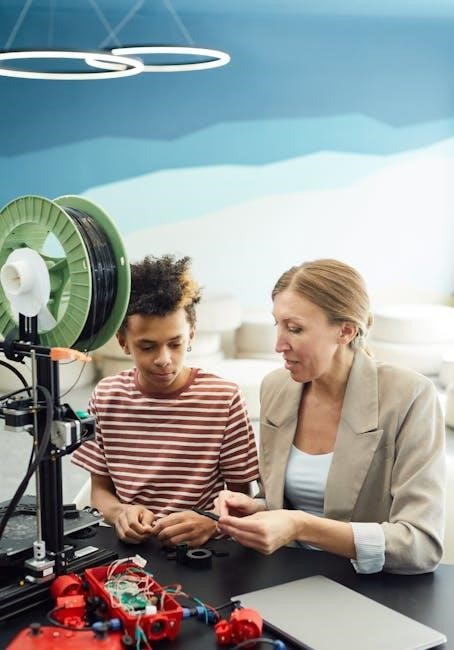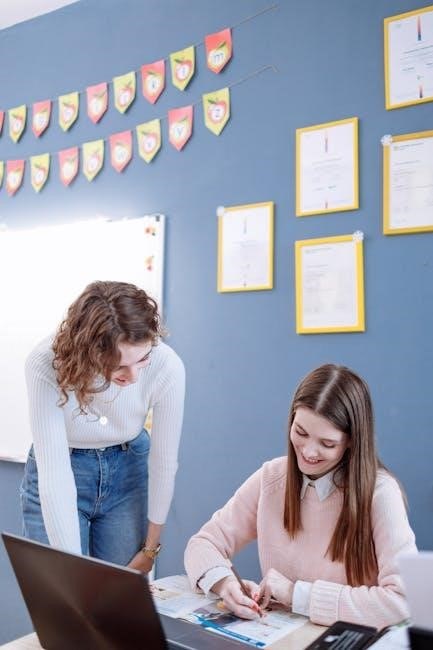Understanding Superlatives
Superlatives help compare three or more things‚ emphasizing the highest degree of a quality. They are essential for clear communication in English. This section provides guidance on correct usage‚ common mistakes‚ and interactive strategies to master superlatives effectively.
Superlatives are a fundamental part of English grammar used to compare three or more things‚ highlighting the highest degree of a particular quality. They help convey clear and precise comparisons‚ making communication more effective. For example‚ saying “This is the fastest car” immediately identifies it as the top choice among multiple options. Superlatives are formed using either the suffix -est (e.g.‚ fastest) or the word most (e.g.‚ most beautiful). They are essential for describing extremes‚ such as the tallest building or the most delicious cake. Understanding superlatives is crucial for fluency in English‚ as they are commonly used in everyday conversations‚ writing‚ and even in academic contexts. Mistakes‚ like using double superlatives (e;g.‚ the most fastest)‚ can confuse meaning‚ so proper usage is key. This section provides a clear guide to mastering superlatives‚ ensuring confidence in their use.
Rules for Forming Superlatives
Mastering the rules for forming superlatives is essential for clear and accurate communication in English. Superlatives are used to compare three or more things‚ identifying which one has the highest degree of a particular quality. The formation of superlatives depends on the type of adjective being used. For one-syllable adjectives‚ the superlative is formed by adding the suffix -est‚ such as fast becoming fastest. For two-syllable adjectives‚ both -est and most can be used‚ for example‚ happy can become happiest or most happy. Adjectives with three or more syllables typically use most‚ such as beautiful becoming most beautiful. Irregular adjectives‚ like good‚ form their superlative differently‚ becoming best. Properly applying these rules ensures that comparisons are both grammatically correct and easily understood. Understanding these guidelines is fundamental for effectively using superlatives in everyday language.
When to Use Superlatives
Superlatives are used to highlight the highest degree of a quality among three or more things. They are essential for emphasizing extremes‚ such as the fastest car‚ the tallest building‚ or the most delicious meal. Use superlatives when comparing groups to identify the item with the most prominent characteristic. For example‚ in a group of students‚ you might say‚ “She is the brightest in the class.” Superlatives are also useful in everyday conversations to add emphasis‚ like stating‚ “This is the best pizza I’ve ever had.” They help clarify comparisons and make language more precise. Superlatives are particularly useful in descriptions‚ opinions‚ and rankings. Always use them when you want to single out one item as exceptional within a set. This ensures clear and impactful communication‚ making your statements more vivid and engaging for others. Mastering when to use superlatives enhances both spoken and written English‚ allowing for more effective expression of ideas and comparisons.
Common Mistakes with Superlatives
When learning superlatives‚ common errors often occur. One frequent mistake is using -est with long adjectives‚ such as saying “the most good” instead of “the best.” Another error is forgetting to use the before superlatives‚ like “She is tallest” instead of “She is the tallest.” Some learners incorrectly add -er to adjectives ending in -est‚ creating forms like “biggestest.” Mixing comparative and superlative forms‚ such as “more fastest‚” is also a mistake. Additionally‚ not using superlatives when required can make comparisons unclear‚ such as saying “She is fast” instead of “She is the fastest.” These errors can confuse meaning and make communication less effective. Awareness of these common mistakes helps learners avoid them and use superlatives correctly in both speaking and writing. Recognizing these pitfalls is crucial for mastering English superlatives and improving overall language accuracy. By understanding and addressing these issues‚ learners can communicate more clearly and effectively in various situations.

Interactive Learning Strategies
Engage with superlatives through interactive quizzes‚ gap-fill exercises‚ and real-life examples. Use visual aids like videos and infographics to enhance understanding. Participate in group discussions and role-plays to practice forming and using superlatives confidently in context.
Engaging Activities for Practice
Engaging activities are essential for mastering superlatives. Start with interactive quizzes and gap-fill exercises to practice forming superlatives. Use online tools or worksheets to fill in the correct forms of adjectives. Conduct class surveys where students gather information about their classmates‚ such as “Who is the tallest?” or “Who has the longest hair?” This activity encourages real-life application and conversation practice.
- Organize group discussions to compare favorite movies‚ books‚ or hobbies using superlatives.
- Role-play scenarios‚ like describing extreme experiences‚ to practice using superlatives naturally.
- Use visual aids like videos or infographics to explore superlatives in context.
Incorporate real-life examples‚ such as creating a “Top 10” list of anything (e.g.‚ countries to visit‚ foods to try) and explaining why each item is the “best” or “most interesting.” These activities make learning fun and relevant‚ helping students gain confidence in using superlatives effectively.
Real-Life Applications of Superlatives

Superlatives are frequently used in everyday conversations and real-life scenarios. For instance‚ when describing extreme experiences‚ such as “the best movie I’ve ever seen” or “the most challenging project at work‚” superlatives add clarity and emphasis. They are also essential in comparisons‚ like rating products‚ describing weather conditions‚ or discussing personal preferences.
In professional settings‚ superlatives can enhance communication. For example‚ in job applications‚ stating “I am the most experienced candidate for this role” highlights strengths effectively. Similarly‚ in travel guides‚ superlatives like “the tallest skyscraper in the city” or “the most scenic hiking trail” help attract visitors and provide clear information.
Understanding superlatives is also practical in social interactions. When sharing opinions‚ such as “This is the funniest comedy I’ve watched this year‚” superlatives make conversations more engaging and expressive. By mastering their use‚ learners can communicate more confidently and precisely in various real-life situations.
Using Visual Aids for Better Comprehension
Visual aids are powerful tools for understanding and mastering superlatives. They help learners connect abstract grammar rules with tangible examples‚ making concepts easier to grasp. Charts‚ infographics‚ and videos are popular resources that break down superlatives into digestible parts.
For instance‚ a comparison chart can illustrate the differences between adjectives‚ comparatives‚ and superlatives. Infographics can highlight key rules‚ such as adding “-est” to short adjectives or using “most” for longer ones. Interactive videos often include gap-fill exercises‚ allowing learners to practice forming superlatives in real-time.
Visual aids also make learning engaging. Color-coded examples‚ diagrams‚ and animated explanations can capture attention and improve retention. Additionally‚ real-life images or scenarios incorporating superlatives help learners see their practical applications‚ making the content more relatable and meaningful.
Overall‚ visual aids enhance comprehension by providing a clear‚ structured‚ and interactive approach to learning superlatives. They cater to different learning styles‚ ensuring that everyone can understand and apply the rules confidently.
Assessment Techniques for Progress Tracking
Regular assessment is crucial to track progress in learning superlatives. Quizzes‚ worksheets‚ and interactive exercises are effective tools to evaluate understanding. These activities can include gap-fill tests‚ multiple-choice questions‚ and sentence completion tasks.
Class discussions and role-playing activities allow teachers to observe students’ ability to use superlatives in context. Peer reviews and group work also provide opportunities for feedback; Digital tools‚ such as online quizzes and interactive games‚ offer immediate results and self-assessment options.
Progress tracking helps identify areas where students may need additional practice. For example‚ students might struggle with irregular superlatives or using “most” correctly. Targeted exercises can then be designed to address these specific challenges.

Assessment not only measures mastery but also motivates learners by showing improvement over time. Celebrating progress‚ no matter how small‚ encourages continued effort and confidence in using superlatives effectively.
Mastering superlatives is a valuable skill that enhances communication in English. By understanding the rules‚ practicing regularly‚ and applying superlatives in real-life situations‚ learners can become confident and fluent in their use.
Encourage learners to continue exploring superlatives through interactive activities‚ such as creating superlative statements about their daily lives or comparing favorite movies‚ books‚ or places. Role-playing and group discussions are excellent ways to apply superlatives in context.

Motivate learners to embrace challenges and celebrate progress‚ no matter how small. Remind them that consistent practice leads to mastery. With patience and dedication‚ using superlatives will become second nature‚ enriching their ability to express themselves effectively in English.

Leave a Reply